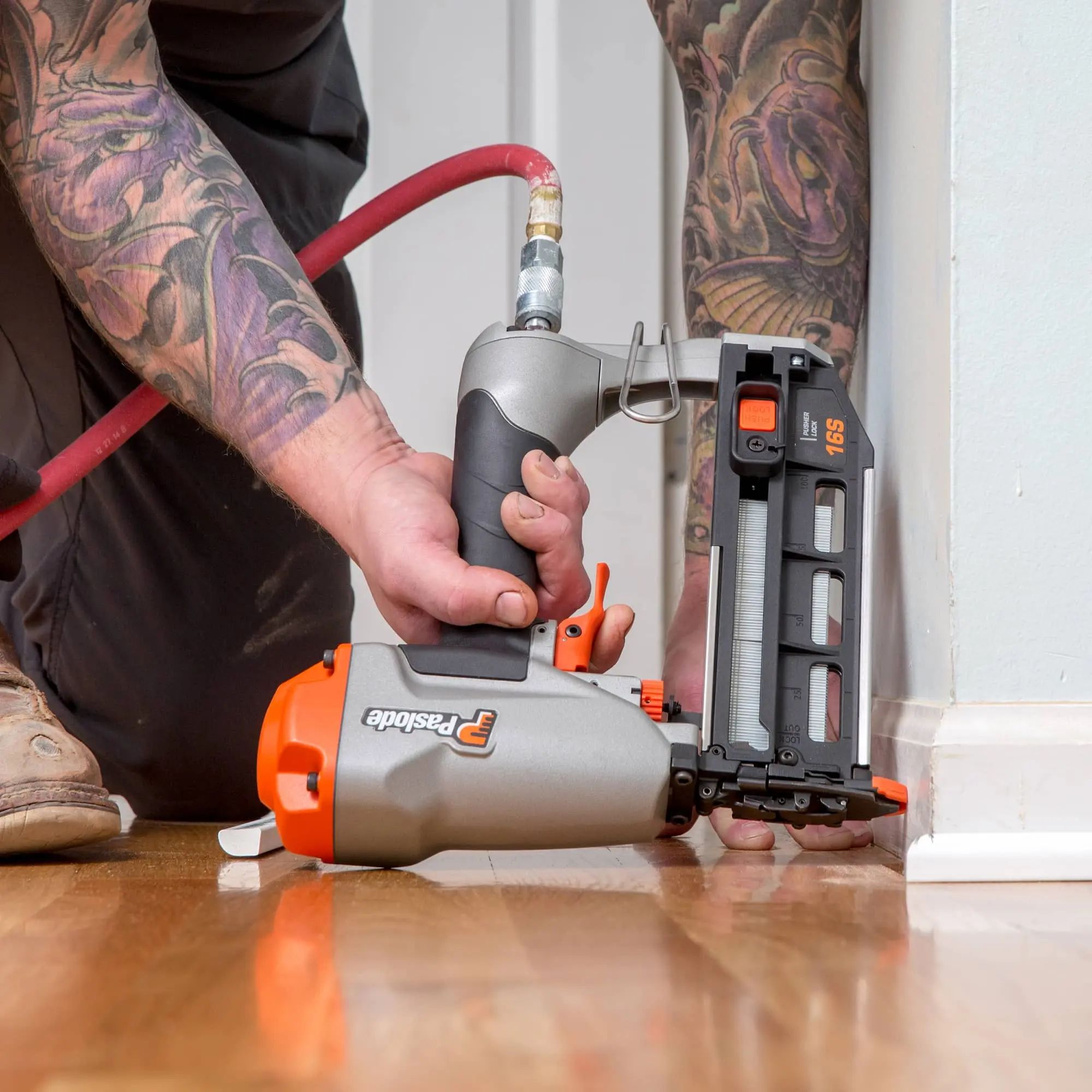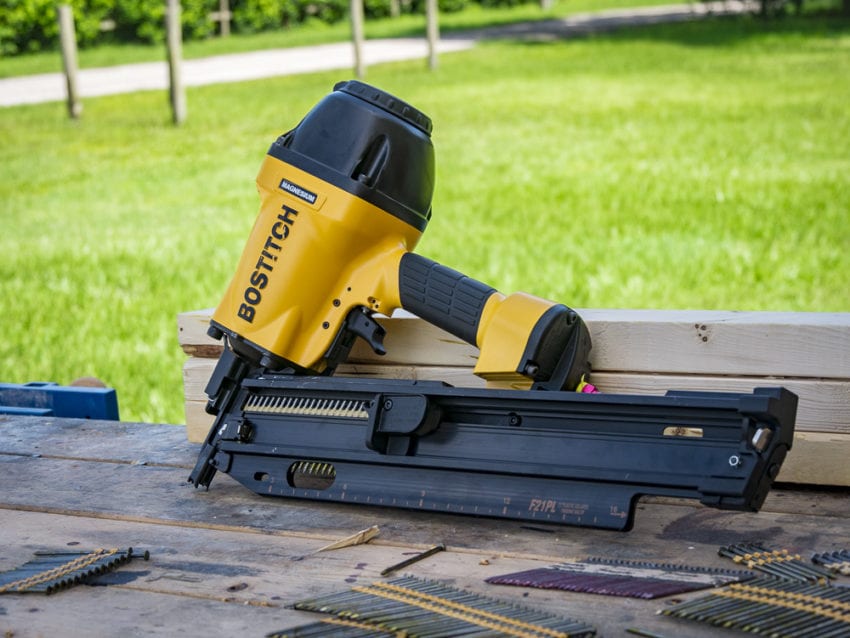It can be tough for people, particularly for beginners, to choose the type of nail gun for each project type. If you’re one of them, this blog post on finish nailer vs framing nailer – is here to save you from this dilemma.
The main difference between these two tools is the nailing operation. This means that a finish nailer drives nails for precision and clean aesthetics. They are perfect for small DIY tasks, thin crown molding, or lightweight home improvement tasks.
In contrast, a framing nailer drives comparatively larger nails (usually 10-12 gauge) to accomplish some heavy duty structural, framing, and decking tasks. These nail gun nails leave visible holes in the wood material.
What Is A Finish Nailer?

In general, a finishing nailer serves to “finish” tasks. A finishing nailer mechanically injects the nail underneath the board’s external layer using a headless nail. It covers the nail hole with a little dab of wood filler, finishing the job.
There are two types of finish nailers – angled or straight finish nailer. Angled finish nailer makes it easy to access minor spaces like corners when setting crown molding and trim.
On the other hand, a straight finish nail gun works well for general home repairs, larger spaces, or nailing into thin boards.
A finish nailer naturally drives either 15 or 16-gauge nails depending on the model. Lower gauge numbers mean larger diameters — 0.072 for 15 gauge nails or 0.0625 inches for 16-gauge nails. So we can say that these nailers drive larger nails than brad nailers.
Pros
- They provide strong holding power.
- Leaves small nail holes that are easy to fill.
- Unlike screws or larger nails, finish nails are less likely to split wood.
- Compatible with wood glue. Ensure extra holding strength when combined with adhesives.
- Can secure thicker materials better than a brad nailer.
Cons
- Wood holes need putty for a seamless finish.
- They may exit the wrong side if the nails are too long or angled incorrectly.
- Can crack or damage thin materials. Unsuitable for delicate trim.
- More Expensive.
What Is A Framing Nailer?

Framing nailers are among the most powerful nailers. They are ideal for major construction and building projects.
They are known as “framing” nailers because they work on tasks requiring 2×4 frames and other heavy materials.
Most nailers can handle nails ranging in length from 114 to 312 inches, which are ideal for nailing down the 2x4s needed for massive projects.
Apart from that, the framing nailers are also segmented into 2 different categories that are 21-degree and 30-degree.
A 21 degree framing nailer is designed to drive nails at a 21 degree angle. It is the most common angle used in framing nailers. In contrast, a 30 degree framing nailer can handle different types of heavy jobs. It is also used for framing applications and lets you easily attach floor joints.
Framing nailers function with nails of various diameters and lengths, but they are only suited for three nail head varieties: round head, clipped head, and offset head.
Round head nails are just what you picture when you think of a nail. It’s a perfect circle that rests neatly on the nail body. These nails have a strong gripping force and are compliant with construction codes.
Clipped head nails resemble round headnails but have a little piece of the head removed, which gives them a more semicircular appearance.
Offset head nails are also perfect circles but with the head offset from the nail body. They can be aggregated closer together to save space if necessary.
Pros
- Can drive large nails quickly to speed up your framing and construction tasks.
- Thick gauge nails provide a secure hold for heavy materials.
- Essential for structural works like framing, decking, and fencing.
- Saves energy and eliminates the need for manual hammering.
- Can penetrate tough wood easily without bending nails.
- Available in Different Angles (21°, 28°, 30°-34°).
- These angles come with better access to tight spaces.
Cons
- Larger and heavier than finish than finish nailers.
- Leaves noticeable holes than finish nails.
- Risk of overdriving nails especially in softer wood.
- Too powerful for thin trim and lightweight baseboards.
Finish Nailer vs Framing Nailer – Key Differences
While both a framing nailer and a finishing nailer serve to drive nails into wood, there are important distinctions between them.
Purpose & Applications
Framing Nailer
- Built for heavy duty construction works.
- Used for building walls, floors, roofs, decks, and fences.
- Commonly used in home building and commercial construction.
- Provides strong and secure connections for large wood structures.
- Suitable for assembling wooden frames, sheathing, and heavy furniture.
Finish Nailer
- Designed for precise, detailed work in woodworking and interior design.
- Ideal for attaching trim, baseboards, crown molding, and cabinets.
- Leaves a clean finish with minimal marks.
- Works well for delicate woodwork like staircases and paneling.
- Used in projects that need a polished and aesthetic look.
Nail Size & Type
Framing Nailer
- Uses thick, strong nails ranging from 2 to 3.5 inches long.
- Nails are often grouped together using wire, plastic, or paper for easy loading.
- Can use round head nails for a strong grip or clipped head nails for more capacity.
- Nails may be coated to resist rust.
- Perfect for securing structures that need to hold heavy loads.
Finish Nailer
- Uses thinner nails, usually 1 to 2.5 inches long.
- Works with 15 or 16 gauge nails which leave small holes.
- Some models use 18 gauge brad nails for finer work.
- Some nails have a sticky coating to improve hold.
- Best for projects where appearance matters.
Power & Strength
Framing Nailer
- Provides strong force to drive nails through thick and tough wood.
- Helps secure load bearing structures for long term durability.
- It can drive nails through multiple wood layers with minimal effort.
- Speeds up large building projects by making framing work faster.
Finish Nailer
- Offers controlled power to avoid splitting wood.
- Best for softer woods, veneers, and decorative pieces.
- Allows for precise depth control for a smooth finish.
- Keeps nails secure without damaging delicate materials.
Variants Based on Power Sources
Framing Nailers
- Pneumatic: Uses air pressure for strong and reliable performance.
- Battery Powered: Cordless and portable but slightly less powerful.
- Gas Powered: Uses a fuel cartridge and battery, great for remote sites.
Finish Nailers
- Straight Finish Nailer: Fires nails at a straight angle, good for general trim work.
- Angled Finish Nailer: Helps reach tight corners and detailed areas.
- Pneumatic Finish Nailer: Uses air for consistent nail driving.
- Battery or Gas Finish Nailer: Portable but may need recharging.
Magazine Type
Framing Nailers
- Coil Magazine: Holds more nails and reduces the nail reloading time.
- Stick Magazine: Easier to handle and balance.
Finish Nailers
- Straight Magazine: Holds nails in a straight line which is common for general trim work.
- Angled Magazine: Holds nails at an angle that makes it easier to reach edged spaces.
Nail Hole Appearance & Finishing Needs
Framing Nailer
- Leaves large and visible holes.
- Focuses on strength rather than appearance.
- May require additional reinforcement like screws or glue.
- Not suitable for projects needing a smooth finish.
Finish Nailer
- Leaves small holes that are easy to hide.
- Provides a clean and polished look.
- Can be used with wood filler to make holes disappear.
- Keeps wood surfaces intact and looking great.
Cost & Practical Considerations
Framing Nailers
- Larger, heavier, and usually more expensive.
- Uses bigger nails and higher air pressure, increasing costs over time.
- Requires safety gear due to high impact force.
- Best for professional contractors and experienced DIYers handling big projects.
Finish Nailers
- Lighter, smaller, and more affordable.
- Uses smaller and cheaper nails to make it cost effective for frequent use.
- Best for woodworking furniture making, and interior finishing.
- Suitable for professionals and hobbyists alike.
Impact
Framing Nailers
- Framing nailers must push nails into heavy wood to get greater impact than finish nailers.
- This impact level is fantastic if you precisely set the nail where you need it to penetrate.
Finish Nailers
- In contrast, a finish nail gun has a smaller impact. This is excellent for detail work.
- However, the reduced impact makes it less ideal for harder materials or heavy projects.
Accuracy
Framing Nailers
- Since framing nailers are intended for quick, heavy duty work.
- They are less precise than finish nailers.
Finish Nailers
- Finish nail guns are more accurate than framing nailer guns.
- Finish nailers are made with precision in mind to ensure that moldings are put in a straight line.
Framing vs Finish Nail Gun – At a Glance
| Feature | Framing Nailer | Finish Nailer |
| Purpose & Applications | Heavy duty construction like walls, floors, roofs, decks, and fences. | Designed for precision work in woodworking and interior design, like trim, molding, and cabinetry. |
| Nail Size & Type | Thick nails (2 – 3.5 inches), collated for easy loading. | Thinner nails (1 – 2.5 inches), 15 or 16 gauge. |
| Nail Variants | Round head for strong grip, clipped head for higher capacity. | Some models use 18 gauge brads. some nails have adhesive coatings for stronger hold. |
| Power & Strength | High power for load bearing structures. Drives nails through multiple layers. | Controlled power to avoid splitting wood. Precise depth control for a smooth finish. |
| Variants Based on Power Sources | Pneumatic (powerful), Battery powered (portable), Gas powered (for remote sites). | Pneumatic (consistent performance), Battery or Gas (portable and requires recharging). |
| Magazine Type | Coil and Stick magazine. | Straight and angled magazine. |
| Nail Hole Appearance & Finishing | Large and visible holes. | Small, clean holes that are easy to hide. |
| Cost & Practical Considerations | Larger, heavier, more expensive. | Lighter and cost-effective for frequent use. |
| Impact Level | High impact for deep penetration in heavy wood. | Low impact for fine detail work. |
| Accuracy | Designed for speed and heavy duty work, less precise. | Made for precision, ensuring straight, clean placement of nails. |
When to Use a Finish Nailer?
A finish nailer is the right tool when working on interior woodworking projects where aesthetics matter.
Best Scenarios
- Installing baseboards, chair rails, and crown molding
- Building furniture and cabinetry
- Attaching window and door trim
- Any project where nail holes need to be small and unnoticeable
Tips for Best Results
- Use a pneumatic or cordless finish nailer for better control.
- Choose the right gauge—15 gauge for heavier trim and 16 gauge for general finish work.
- Fill nail holes with wood filler for a seamless look.
- Keep nail length in mind—1.5 to 2.5 inches is ideal for trim and moldings.
- Work at a consistent angle to prevent splitting delicate wood.
Finishing nailers only utilize one head type since they employ small nails for detail work. This is because the head is preferably so tiny that the shape is irrelevant. The smaller the head, the less touchup the project needs.
When to Use a Framing Nailer?
A framing nailer is essential for projects that require strength and durability.
Best Scenarios
- Framing walls, decks, and fences
- Building sheds, garages, and large structures
- Installing subflooring and roofing
- Any heavy-duty construction project
Tips for Best Results
- Choose the correct degree (21° or 30°) for your project.
- Use pneumatic framing nailers for consistent power.
- Ensure nails meet building code requirements for load-bearing structures.
- Adjust air pressure properly—too high can split wood, and too low won’t sink nails deep enough.
- Wear safety gear—framing nailers are powerful and can cause serious injuries.
The framing nailer you require is determined by the nail head you choose. Many professionals prefer framing nailers with rounder heads.
Roundhead frame nailers are more secure and reliable since these nailers ensure that all constructions meet regulatory parameter.
Hobbyists and homeowners almost mainly use clipped headnailers. Most standards do not permit clipped nails.
As a result, they are primarily used for personal projects. They speed up personal jobs by reducing the need for extra nails.
Can One Nailer Replace the Other?
Using a Finish Nailer for Framing?
Not a good idea! Finish nailers are made for detailed work with smaller nails, which don’t have the strength to build strong structures.
If you try to use a finish nailer for framing, the joints might not hold up well over time. Also, finish nailers don’t drive nails deep enough into thick wood, making them unreliable for framing jobs.
Using a Framing Nailer for Finish Work?
Also not a good choice! Framing nailers shoot larger and thicker nails to go through heavy wood. These nails are too large for trim and molding work.
They often split thin wood and leave big holes that need extra filling and sanding. Plus, framing nails don’t hold small, delicate pieces as well as finish nails do.
When Can One Be Used Instead of the Other?
Small DIY projects
If the project doesn’t need a super strong hold you might get away with using a finish nailer instead of a framing nailer. But for bigger or more important builds, a framing nail gun is a must.
Using a framing nailer carefully
If you have no choice but to use a framing nailer for finish work, you can try lowering its power or using smaller nails.
Still, this is risky since framing nailers are too strong for detailed work and can damage delicate wood.
Temporary fixes
A finish nailer might work to hold pieces together for a short time before you secure them with screws or stronger fasteners.
This is okay for lightweight projects but should not be used for anything that needs long term durability.
Final Verdict: Framing Nailer vs Finish Nailer
Choosing between a finish nailer and a framing nailer depends on the type of work you are doing. Neither one is always “better”—each is made for a specific purpose.
I know, it is very tough to make a final decision regarding tool choosing. Hence, I have tried to make it easy with some simple points.
- Pick a Finish Nailer if you need accuracy, an aesthetic appearance, and small nail holes for trim work, molding, cabinets, or furniture.
- Pick a Framing Nailer if you need power, strength, and a secure hold for framing, decking, fencing, or other big building projects.
If you work on both big and small projects, having both nailers is a great option. They complement each other and allow you to handle different types of woodworking and construction jobs with ease.
FAQs
Can a finishing nailer be used for framing?
Ans: No, it is not recommended at all by the tool experts. It may cause major problems for your tool.
Can a framing nailer be used for trim?
Ans: Not a good idea! A framing nailer is too powerful and uses large nails that can split trim. If the trim is thick and heavy like in a garage, then you can use a framing nail gun for trim.

